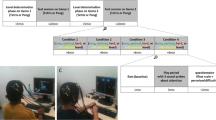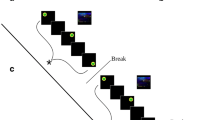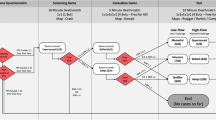Abstract
Games are captivating from a human-computer interaction point of view. They can induce an intensely involving and engaging experience termed flow, which refers to the optimal state of experience when one is fully immersed in an activity. This paper provides a review of the neural and psychophysiological correlates of flow as well as some directions for future research.
You have full access to this open access chapter, Download conference paper PDF
Similar content being viewed by others
Keywords
- Neural correlates
- Psychophysiological correlates
- Brain imaging
- Electroencephalogram
- Functional magnetic resonance imaging
- Flow
1 Introduction
Gaming has become a realizable form of entertainment for players of all ages and background [1]. Video games can evoke strong feelings due to their simulated environments, and such feelings are characterized by activations of the temporal, parietal, and dorsolateral areas [2,3,4,5]. Some studies have linked brain activities to video game play. An example of such studies is the use of a content-based event-related analysis for investigating the neural correlates of circumscribed gameplay events [6]. In this review paper, we identify the neural and psychophysiological correlates of the state of flow.
Flow is an optimal experience where people are so involved in an activity that they lose track of time and nothing else seems to matter. It is a subjective experience of effortless attention, reduced self-awareness, and enjoyment that typically occurs during optimal task performance [7]. Flow can occur when the challenge posed by a task matches the skill of the individual carrying out the task [7,8,9]. However, it is still not known what exactly happens in the brain when the flow state is achieved.
The human brain acts as a duty director for the human nervous system. It is composed of many interconnected neurons that form a complex system, from which thought, behavior, and creativity emerge. It receives information from the sensory organs and delivers output to the muscles. The cerebrum is largely responsible for the execution of cognitive functions. The frontal lobes of the cerebrum are responsible for executive control actions [10]. The frontal lobes are a large brain region representing 30% of the cortical surface. Brain activities can differ from one state to another; EEG is a technique/tool that can be used to record such activities using waveforms [11]. Research has shown that during the state of flow, the cortical activity is reduced [12].
2 Literature Review
Flow represents a psychological state where people are completely absorbed or engaged in an activity and are performing on the edge of their ability [13]. Flow has been conceptualized to comprise the following nine components [7]:
-
1.
Balance of challenge and skill: A key aspect of the state of flow is that the skill of the individual and the challenge of the activity need to be in balance with each other. If the challenge is less than the skill, boredom occurs. If the challenge is substantially higher than the skill, anxiety can arise.
-
2.
Clear goals: The goals/objectives of the task or activity must be clear and unambiguous.
-
3.
Immediate feedback: The performance feedback on the task or activity should be clear, immediate, and unambiguous.
-
4.
Paradox of control: The individual perceives control of his/her actions and the environment.
-
5.
Loss of self-consciousness: Because of the pre-occupied activity, the individual “loses” oneself and experiences a sense of separation from the world around him/her.
-
6.
Concentration on task at hand: The individual focuses or pays complete attention on the task or activity, such that all other distractions are blocked from his/her awareness.
-
7.
Transformation of time: Time no longer seems to pass the way it normally does. The individual loses track of time and the perception of time is distorted.
-
8.
Merging of action and awareness: The individual is so involved in the activity that his/her actions become spontaneous, just like automatic responses.
-
9.
Autotelic nature: The activity that consumes the individual is intrinsically rewarding and motivating to him/her.
The relationship between skill and challenge lays the foundation for the psychological state or concept of flow [14]. An opportunity to perform an action is considered as challenge, and the capability to perform that action is known as skill. In the state of flow, attention is effortless [9]. When one is in flow, “one is given over to the activity so thoroughly that action and attention seem effortless” [15, p. 1].
3 Neuropsychophysiological Correlates of Flow
This review focuses on synthesizing the literature on neuropsychophysiological correlates of flow. The following databases have been utilized for identifying relevant published articles: ACM Digital Library, Scopus, PsycINFO, ABI/Inform, and IEEE. We have used various combinations of search keywords: ‘neural’, ‘physiological’, ‘psychophysiological’, ‘correlates’, ‘flow’, ‘brain activity’, ‘cortex activity’, ‘gaming’, ‘electroencephalogram (EEG)’, ‘brain imaging’. The set of articles included in the review is comprised of a combination of conceptual and empirical papers. The findings are presented in Table 1.
The nervous system is the core component of the brain, and neurons are the core components of the nervous system. Neurons operate on electrical impulses and chemical signals [12]. The human brain can be generally divided into three parts: (1) Forebrain (2) Midbrain (3) Hindbrain [10]. The cerebrum is responsible for most cognitive functions. The cerebrum, or cortex, is channeled into four lobes: frontal, parietal, occipital, and temporal. Each lobe has its specific predefined set of functions to perform. The functions of the lobes are: frontal – planning, motor/physical movement, emotion, problem solving; parietal – perception of stimuli, associated with movement and recognition; occipital – visual processing; temporal – memory, speech, perception and recognition of auditory stimuli. The largest portion of the brain is the cerebrum, which is widely channeled into two parts, the left and right hemispheres [10].
The frontal lobe functions are related to central executive processes [31]. Some research studies have shown that executive actions do not depend on frontal cortical activation but rely on the frontal-parietal network [32]. Prefrontal Cortex (PFC) in the front lobe of the brain is responsible for the execution of cognitive functions [32]. Most of the user-game engagement brain activities occur in Dorsolateral Prefrontal Cortex (DLPFC), which is the prefrontal cortex of the brain [26]. Previous research has shown that DLPFC is responsible for executive functions such as cognitive flexibility, planning, inhibition, and reasoning [32,33,34]. Medial prefrontal cortex (mPFC) plays a role in the integration of emotional and cognitive processes by incorporating emotional biasing signals or markers into the decision-making process [18]. EEG recordings are converted into spectral band frequencies (delta, theta, beta, alpha, and gamma) [35].
The alpha, low-beta, and mid-beta bands show greatest differences between three states of user experience, namely, flow, boredom, and anxiety. The frontal and parietal regions have low activity when one is in flow [28]. In addition, the alpha band is positively correlated with flow, whereas the beta band is negatively correlated with flow. The theta oscillations from the left side of the DLPFC can explain engagement [29].
EEG oscillations resemble the synchronized activities in the neuronal population in the brain [36]. These oscillations represent a subset of the brain’s electrical activities at a point in time. We can record these activities on the surface of the scalp with the help of electrodes (EEG headset). Many neurons will need to be synchronously active to detect oscillations of an activity at the scalp level [35]. Researchers have estimated that tens of thousands of synchronously activated pyramidal cortical neurons are involved for an EEG oscillation to emerge [37, 38]. In EEG research, the oscillations are classified into low-frequency oscillations and high-frequency oscillations. Delta and theta waves are considered low frequency, whereas beta, alpha, and gamma waves are considered high frequency.
Delta waves (1–4 Hz) are primarily associated with deep sleep (sometimes coma) but can also be present in the waking state. The power of the theta oscillations increases when information is retrieved from working memory [39, 40] because theta is related to memory performance [33, 41]. Theta waves (4–8 Hz) are associated with creative inspiration and deep meditation, and they arise when consciousness slips. An increase in game engagement implies a reduction in the density of theta oscillations [42].
Alpha (8–12 Hz) usually appears over the occipital region (posterior regions). Alpha represents relaxed awareness. Alpha waves are produced with the eyes closed and they signal a scanning or waiting pattern [43]. Alpha waves are reduced or eliminated by opening the eyes, by hearing unfamiliar sounds, or by anxiety [44]. Alpha oscillations are also considered indicators of the notion of happiness. Alpha oscillations increase with focus or concentration [45]. The upper alpha oscillations are associated mainly with long-term memory processes [12]. For the upper alpha band, the connectivity decreases in a condition with higher executive demands [46].
Beta (12–30 Hz) primarily deals with active thinking, active attention, focus on the outside world, and solving concrete problems. A very high beta represents a person’s panic state, and is found in frontal and central regions. Gamma (30–32 Hz) represent arousal. The rate of gamma wave occurrence is very low [35].
In summary, brain activity in the cortical regions, especially in frontal and parietal lobes, decreases during the state of flow. The alpha band is positively correlated with flow, the beta band tends to be negatively correlated with flow, and the theta oscillations from the left side of the DLPFC correlate with flow.
4 Conclusion and Future Research
In our ongoing and future research, we are interested to assess the neuropsychophysiological correlates of different states of user experience including flow, boredom, and anxiety, as well as the degree to which user states can be explained by or assessed using their neuropsychophysiological correlates. We plan to use time frequency decomposition and machine learning techniques to address the above questions. One of the main goals of our research is to improve the assessment and evaluation of user experience in human-computer interaction research. We are also interested to utilize both the questionnaire approach and the neuropsychophysiological correlates of flow to test and assess a theoretical framework for flow in gaming developed by Nah and her colleagues [47]. Another implication of this research is to contribute to improving brain-computer interfaces of smart devices by having computers respond to users based on the users’ states of experience.
References
Hartmann, T., Klimmt, C.: Gender and computer games: exploring females’ dislikes. J. Comput. Mediated Commun. 11(4), 910–931 (2006)
Baumgartner, T., Speck, D., Wettstein, D., Masnari, O., Beeli, G., Jäncke, L.: Feeling present in arousing virtual reality worlds: prefrontal brain regions differentially orchestrate presence experience in adults and children. Front. Hum. Neurosci. 2(8), 1–12 (2008)
Fairclough, S.H.: Psychophysiological inference and physiological computer games. In: Brain-Computer Interfaces and Games Workshop at Advances in Computer Entertainment, p. 19 (2007)
Peifer, C.: Psychophysiological correlates of flow-experience. In: Engeser, S. (ed.) Advances in Flow Research, pp. 139–164. Springer, New York (2012)
Rani, P., Sarkar, N., Liu, C.: Maintaining optimal challenge in computer games through real-time physiological feedback. In: Proceedings of the 11th International Conference on Human Computer Interaction, vol. 58, pp. 22–27, July 2005
Weber, R., Ritterfeld, U., Mathiak, K.: Does playing violent video games induce aggression? Empirical evidence of a functional magnetic resonance imaging study. Media Psychol. 8(1), 39–60 (2006)
Csikszentmihalyi, M.: Flow: The Psychology of Optimal Experience. Harper & Row, New York (1990)
Anshel, M.H.: Sport Psychology: From Theory to Practice. Pearson, San Francisco (2011)
Csikszentmihalyi, M.: Finding Flow: The Psychology of Engagement with Everyday Life. Basic Books, New York (1997)
Miller, B.L., Cummings, J.L.: The Human Frontal Lobes: Functions and Disorders. Guilford Press, New York (2007)
Libenson, M.H.: Practical approach to electroencephalography. Elsevier Health Sciences, Philadelphia (2012)
Goldberg, I.I., Harel, M., Malach, R.: When the brain loses its self: prefrontal inactivation during sensorimotor processing. Neuron 50(2), 329–339 (2006)
Csikszentmihalyi, M., Csikszentmihalyi, I.S.: Optimal Experience: Psychological Studies of Flow in Consciousness. Cambridge University Press, Cambridge (1992)
Nah, F., Eschenbrenner, B., DeWester, D., Park, S.: Impact of flow and brand equity in 3D virtual worlds. J. Database Manag. 21(3), 69–89 (2010)
Kahneman, D.: Attention and Effort. Prentice-Hall, Englewood Cliffs (1973)
Hamilton, J.A., Haier, R.J., Buchsbaum, M.S.: Intrinsic enjoyment and boredom coping scales: validation with personality, evoked potential and attention measures. Pers. Individ. Differ. 5(2), 183–193 (1984)
Gusnard, D.A., Akbudak, E., Shulman, G.L., Raichle, M.E.: Medial prefrontal cortex and self-referential mental activity: relation to a default mode of brain function. Proc. Nat. Acad. Sci. 98(7), 4259–4264 (2001)
Marr, A.J.: In the zone: a biobehavioral theory of the flow experience. Athletic Insight Online J. Sport Psychol. 3(1) (2001). http://www.athleticinsight.com/Vol3Iss1/Commentary.htm
Dietrich, A.: Neurocognitive mechanisms underlying the experience of flow. Conscious. Cogn. 13(4), 746–761 (2004)
Sanchez-Vives, M.V., Slater, M.: From presence to consciousness through virtual reality. Nat. Rev. Neurosci. 6(4), 332–339 (2005)
Kivikangas, J.M.: Psychophysiology of flow experience: an explorative study, Master’s thesis, University of Helsinki (2006)
Mandryk, R.L., Atkins, M.S.: A fuzzy physiological approach for continuously modeling emotion during interaction with play technologies. Int. J. Hum Comput Stud. 65(4), 329–347 (2007)
Nacke, L., Lindley, C.A.: Affective ludology, flow and immersion in a first-person shooter: measurement of player experience. J. Can. Game Stud. Assoc. 3(5), 1–22 (2009)
De Manzano, Ö., Theorell, T., Harmat, L., Ullén, F.: The psychophysiology of flow during piano playing. Emotion 10(3), 301–311 (2010)
Keller, J., Bless, H., Blomann, F., Kleinböhl, D.: Physiological aspects of flow experiences: skills-demand-compatibility effects on heart rate variability and salivary cortisol. J. Exp. Soc. Psychol. 47(4), 849–852 (2011)
Klasen, M., Weber, R., Kircher, T.T., Mathiak, K.A., Mathiak, K.: Neural contributions to flow experience during video game playing. Soc. Cogn. Affect. Neurosci. 7(4), 485–495 (2012)
Bavelier, D., Achtman, R.L., Mani, M., Focker, J.: Neural bases of selective attention in action video game players. Vis. Res. 61, 132–143 (2012)
Berta, R., Bellotti, F., De Gloria, A., Pranantha, D., Schatten, C.: Electroencephalogram and physiological signal analysis for assessing flow in games. IEEE Trans. Comput. Intell. AI Games 5(2), 164–175 (2013)
Léger, P.M., Davis, F.D., Cronan, T.P., Perret, J.: Neurophysiological correlates of cognitive absorption in an enactive training context. Comput. Hum. Behav. 34, 273–283 (2014)
Li, M., Jiang, Q., Tan, C.H., Wei, K.K.: Enhancing user-game engagement through software gaming elements. J. Manag. Inf. Syst. 30(4), 115–150 (2014)
Sanei, S., Chambers, J.A.: EEG Signal Processing. John Wiley & Sons, Chichester (2013)
Collette, F., Vander, L.M.: Brain imaging of the central executive component of working memory. Neurosci. Biobehav. Rev. 26(2), 105–125 (2002)
Babiloni, C., Babiloni, F., Carducci, F., Cappa, S.F., Cincotti, F., Del Percio, C., Miniussi, C., Vito Moretti, D., Rossi, S., Sosta, K., Rossini, P.M.: Human cortical rhythms during visual delayed choice reaction time tasks: a high-resolution EEG study on normal aging. Behav. Brain Res. 153(1), 261–271 (2004)
Brann, D.W., Dhandapani, K., Wakade, C., Mahesh, V.B., Khan, M.M.: Neurotrophic and neuroprotective actions of estrogen: basic mechanisms and clinical implications. Steroids 72(5), 381–405 (2007)
Müller-Putz, G.R., Riedl, R., Wriessnegger, S.C.: Electroencephalography (EEG) as a research tool in the information systems discipline: foundations, measurement, and applications. Commun. Assoc. Inf. Syst. 37(1), 1–46 (2015)
Okada, Y.: Empirical bases for constraints in current-imaging algorithms. Brain Topogr. 5(4), 373–377 (1993)
Baillet, S., Mosher, J.C., Leahy, R.M.: Electromagnetic brain mapping. IEEE Signal Process. Mag. 18(6), 14–30 (2001)
Pizzagalli, D.A.: Electroencephalography and high-density electrophysiological source localization. Handb. Psychophysiol. 3, 56–84 (2007)
Speckmann, E.J., Elger, C.E., Gorji, A.: Neurophysiological basis of EEG and DC potentials. In: Schomer, D.L., da Silva, F.L. (eds.) Niedermeyer’s Electroencephalography: Basic Principles, Clinical Applications, and Related Fields, pp. 17–32. Lippincott Williams & Wilkins, Philadelphia (2011)
Jensen, O., Tesche, C.D.: Frontal theta activity in humans increases with memory load in a working memory task. Eur. J. Neurosci. 15(8), 1395–1399 (2002)
Klimesch, W., Schimke, H., Schwaiger, J.: Episodic and semantic memory: an analysis in the EEG theta and alpha band. Electroencephalogr. Clin. Neurophysiology 91(6), 428–441 (1994)
Klimesch, W., Doppelmayr, M., Russegger, H., Pachinger, T.: Theta band power in the human scalp EEG and the encoding of new information. NeuroReport 7(7), 1235–1240 (1996)
Horne, J.A.: Why We Sleep: The Functions of Sleep in Humans and Other Animals. Oxford University Press, Oxford (1988)
Da Silva, F.L.: Neural mechanisms underlying brain waves: from neural membranes to networks. Electroencephalogr. Clin. Neurophysiol. 79(2), 81–93 (1991)
Pfurtscheller, G., Stancak, A., Neuper, C.: Event-related synchronization (ERS) in the alpha band—an electrophysiological correlate of cortical idling: a review. Int. J. Psychophysiol. 24(1), 39–46 (1996)
Sauseng, P., Klimesch, W., Schabus, M., Doppelmayr, M.: Fronto-parietal EEG coherence in theta and upper alpha reflect central executive functions of working memory. Int. J. Psychophysiol. 57(2), 97–103 (2005)
Nah, F., Eschenbrenner, B., Zeng, Q., Telaprolu, V., Sepehr, S.: Flow in gaming: literature synthesis and framework development. Int. J. Inf. Syst. Manag. 1(1/2), 83–124 (2014)
Author information
Authors and Affiliations
Corresponding author
Editor information
Editors and Affiliations
Rights and permissions
Copyright information
© 2017 Springer International Publishing AG
About this paper
Cite this paper
Nah, F.FH., Yelamanchili, T., Siau, K. (2017). A Review on Neuropsychophysiological Correlates of Flow. In: Nah, FH., Tan, CH. (eds) HCI in Business, Government and Organizations. Supporting Business. HCIBGO 2017. Lecture Notes in Computer Science(), vol 10294. Springer, Cham. https://doi.org/10.1007/978-3-319-58484-3_28
Download citation
DOI: https://doi.org/10.1007/978-3-319-58484-3_28
Published:
Publisher Name: Springer, Cham
Print ISBN: 978-3-319-58483-6
Online ISBN: 978-3-319-58484-3
eBook Packages: Computer ScienceComputer Science (R0)




